News & Updates
Date:- January 24th, 2017-5 Shopper Segments that boost Email Marketing
Key Speakers: Mr. Armando Roggio (Contributing Editor, Practical Ecommerce)
Klaviyo which is a marketing automation platform was the main sponsor to this webinar.
Premise
Email continues to be observed as amongst the most effective ways of executing digital marketing. It can be personalized based on the segment or sent on mass basis if such requirements arise. There are five aspects that must be studied before initiative email marketing. They are as follows:
· Shopping loyalty
· Marketing interaction
· Website and buying behaviour
· Social contest activity
· Life changing purchase behaviour
Thorough research on these aspects is a must for any marketer. This write-up will now explore those five points in greater detail.
Shopping Loyalty
Varying levels of shopping loyalty exist in the market. Shoppers may be categorized under the following heads:
· VIP Customers
· Frequent Customers
· Recent Customers
· Binge Customers
· Missing Customers
· Subscribers who are not Customers
As the name suggests, VIP customers are those who are loyal customers and even act as brand advocates, referring the product to several others. As per marketing research published on a white paper by Adobe, it emerges that only eight percent of visitors to any particular website or store in North America generate a whopping forty one percent of its total revenue. This is in stark contrast to the rest of the ninety two percent of the visitors who are only responsible for the remaining fifty nine percent. Thus it is obvious that no efforts must lag in retaining loyal customers and to make brand advocates out of them. In Europe the gap is even more as loyal customers account for seven times more shopping volume than the others.
Frequent customers as a category are just one notch below and can soon be upgraded to the VIP category. Recent customers have only lately been brought in to the fold. Binge customers, as the name suggests do most of their shopping at any particular times of the year, such as festivals, holidays or special personal occasions.
There exist those who subscribe to brand content but have not yet made any purchase. On the other hand, there are missing customers who have not shown any interest in the brand. It is these last two categories that can best be converted through mass marketing means.
A typical email marketing flow may be described in the illustration below:

At the initial phase, a complete blast of emails is made to an entire database. Then profiles are extracted that are best suited to the product. Lookalike profiles are segmented together based on common tastes, requirements and interests. Then the buying behaviour of group is noted. All this data is collated together to conduct a business analytics operations. Once the numbers are out, the system can be worked to provide predictive analytics which will help in predicting market and customer moves. This will allow the marketer to stay ahead of the competition.
Marketing Interaction
It has been studied that there is on average a forty percent increase in the average open rates once positive marketing interaction is carried out. It triples the average revenue per campaign. In fact there is nearly a fifteen percent rise in revenues with this method being applied than on un-segmented groups.
Website and Buying Behaviour
At this stage, data is collated from the website to study browsing and purchase behaviour of the customer base. The business intelligence then gauged, helps the marketers in optimizing their strategies. Echo Club for example has been able to pinpoint the exact time and day of the week with the highest email open rates. The best time with maximum actual conversions is also recorded.
Certain buyers spend a substantial part of their visit time on a certain page, so ads pertaining to those products must be beamed across to them. Even a seemingly trivial piece of data such as shopping cart abandonment rates tells a certain story. If at a particular time of the year, any shopper tends to use a lot of shipping, that person can at an earlier point be sent free shipping or subscription offers as hook points.
Social Contest Activity
As the name suggests, this phase is about using social media to engage audiences. Games and contests can be run to keep the customer base hooked as well as to provide them with useful information. The number of entrants, entries, likes, shares, invites and visits must all be tracked here. Social media can open up a window into people’s lives as people freely share content.
Life changing Purchase Behaviour
There are certain points in life which make a sudden change in buying behaviors. This could include examples such as going higher education, marriage, pregnancy, having children, change in job, transfer to new location or even country, retirement or death of close relatives. The marketers need to be sensitive enough to foresee what could be these circumstances and how best the brand can provide solutions during this time of flux.
US retail giant Target for example used Big Data to predict times when customers would buy certain products. Specifically they were able to predict pregnancy among women. Post pregnancy or post child-birth, families tended to buy baby-care products, thus such products’ ads would be extremely relevant to them. They were able to predict pregnancies due to sophisticated algorithms but also a perceptive nature on customer behaviour.
Similarly, another company which deals with pet food was able to insert relevant advertisements related to animal growth. Families that had puppies, were sent advertisements on dog food and requirements that dogs get when they get older. Real animal faces encouraged greater connect between the marketer and the final consumer.
At the end of the webinar, the speaker advised all viewers to taka demo of Klaviyo’s software. A senior representative from Klaviyo took five minutes to introduce his product and how it is useful for people working in this line.
Date:- January 25th, 2017-3 Powerful Marketing and Sales Alignment Strategies
Key Speakers: Ms. Heidi Bullock (GVP- Global Marketing, Marketo)
Premise
Sales and marketing have for long been competing, rendering the system broken at several organizations. Greater alignment is needed between the two. For this some effective methods have been identified.
Marketing Challenges
Marketers are constantly beset by some common challenges. While they are supposed to generate more leads, simply having high numbers is not enough. It is important to have such effective prospects under the right accounts. The resources are always at a crunch, but the best of results need to be produced. There is constant bickering between sales and marketing. Even on matters where their point of view is similar, they tend to differ, often arguing for the sake of it. Another major challenge is the unclear ROI on each investment.
Key Considerations
Before the alignment can be fixed, some key considerations need to be looked in to. First of all the revenue model needs to be defined along with its various stages. Then it is important that the marketers work backwards from the objective. While the corporate strategy is paramount, it need not be the starting point. The tactics can be molded as the chain moves along. After this, the entire buyer journey needs to be mapped out. Inbound used to be the preferred mode of digital marketing, but account based strategies are more popular now. The former method is ideal for mass campaigns aimed at a broad reach. The latter on the other hand is specific and targeted towards key clients.
Measurement is extremely crucial. The entire analysis phase can be further divided into early, mid and late sub-stages. Proper metrics must be defined and scores assessed against earlier benchmarks set. Such quantification will allow the team to extract vital business intelligence. Technology must never be used as a mass tool which must be leveraged. Instead, it must only be used to the extent deemed vital for the business. Due diligence must be conducted before any new technology is bandied out to team members. The metrics discussed earlier must be used to compare figures against the previous year or any set standards. Unfair comparisons must not be made between unrelated or unequal objects. Finally, the most important part is team management. Collaboration is vital at this stage beyond the individual preferences.
Technology: How Automation can Help?
With automation taking over in a big way, businesses need to find ways to remain relevant and for their staff to remain thoroughly engaged. Along with this they must also ensure that they have access to a talent pipeline so their employees’ skills do not get outmoded. Either way, business targets will need to be met. A three-pronged process has been known to execute this alignment. It can be better understood using the following illustration:

At the attract stage, the idea is to drive greater inbound traffic to the website. The visitors must be somehow converted to leads. However, attracting the right buyer or accounts is necessary. Traffic can be increased through a plethora of ways such as SEO or SEM. A data warehousing operation must be launched on the experiences of existing visitors. Once their usage patterns are understood, personalized content must be disbursed to them. This will give the marketer as well as the sales development team, the understanding of who are the right buyers or accounts. Constant testing is needed at the attract stage. Business analytics may be used to assess data on information such as recipients and open rate.
At the engage stage, marketers must try to keep the customer base engaged using a variety of means. This includes social networks, news feeds, newspaper ads or articles, reviews, in-store experiences, email and television. This is a crucial stage for the alignment. Sales must be kept in the loop of activities that marketing is performing. Decision makers and influencers must be identified at the very beginning. This is also the stage where awareness in drilled in using social media, events or website personalization. Direct mail campaigns can help locate the real market influencers. Ultimately none of this will ever be successful without adequate campaign scaling. One can even resort to opting for programme cloning. Costs must be assessed at this stage. Even the personalized campaigns need to be scaled for the market requirements.
At the Close stage, it is crucial to generated feedback on activities done till that point. Adequate ought to be accorded to sales representatives so that they can use modern tools. However, at this stage, all the metrics decided must be flexible enough. The task of ranking leads may be done in collaboration between marketing and sales teams. In this way, the prospects must be set as priority. Accountability must be set for the sales staff as well. This needs to be detailed as to the fall back option, in case it ever goes wrong.
The marketing and sales teams must meet up frequently to discuss upcoming and ongoing campaigns. Even sales calls may be done in tandem. Each team must provide valuable feedback to the other. Measurement must be made of each facet of the campaign. This includes aspects such as content syndication, effectiveness of content or email, events, webinars, website or mentions on social media. Marketers ultimately need to grasp the important points and trade points that really succeed. Marketo has specifically created a dashboard so that it becomes easier to collaborate between the two. They will also experience a rise in channeling the prospects through the right position in the funnel.
People Matters
In order to align the teams’ targets together, it is important to first get the members on board. The sales professionals think in terms of revenue, deals and targets. The marketer on the other hand is worried about leads, events, social media, content and branding. Common language needs to be spoken so that there is all round empathy at the common table. Teams must be paired up with a member each from each of the designations. This also helps create a culture of checks and balances as individuals are forced to go out of their comfort territory.
Forum: https://www.marketo.com/
Date:- January 24th, 2017-Top 10 Advocacy and Referral Strategies for 2017
Key Speakers: Ms. Kerry O’Shea Gorgone (Director- Project Strategy & Training, Marketing Profs) and Ms. Jen Gray (Director- Marketing, Extole)
Advocacy and Referral
Customer acquisition has always been a complicated process. A tactic that several marketers often unintentionally ignore is the one through referrals of existing customers. Brand advocates bring multiple benefits. This tactic is all the more important in the e-commerce industry as only one dominant player holds tremendous sway over the market. A study conducted puts Amazon’s share of the total to nearly three-fourths of the entire market. Their total revenue from e-commerce last year was put at just short of eighty billion US dollars compared to a measly fifteen billion plus of Wal-Mart. Amazon is a leader in marketing, but for other players to emerge and sustain their models, an effective advocacy model is required leveraging their most satisfied customers.
Top 10
The top ten are listed as follows:
· Design for Mobile-first
· Refer right after Purchase
· Connect site to Store
· Refer specific Products and Content
· Don’t forget about e-mail
· Tap into your Loyalty Members
· Get Interactive with Customers
· Use Faces everywhere
· Analyze campaign and promotion trends
· Turn every Customer into an Advocate
Let us now individually look at all these strategies.
Design for Mobile-first
It is a well known fact that mobile phones are increasing in their bandwidth of commercial sales. This can be confirmed through the marketing research conducted by Extole which states that in 2015, their overall share of all e-commerce stood at a fourth of the market but has now increased to just short of a third. Only eighteen percent of overall referrals are sent using smart phones but more than the double of that figure standing at just short of forty percent, is received by customers on those devices. People are constantly connected and on the move, so this trend must be capitalized on. Checkmate has got the art of native sharing extremely well.
Refer right after Purchase
At the time the customer buys the product, is when he/she is most excited about it. So this is the time the brand must attach itself with incentives to refer. Research suggests that customers at this satge are sixteen times more likely to refer the product to any acquaintance. That is the reason that retailer Sephora is tracking experiences of customers immediately after purchase. This will provide the retailer valuable business intelligence on use patterns at this stage to optimize the referral procedure.
Connect site to Store
Some in-store shopping tool or app must be developed to enable the seamless transition from the website to the store. This works both ways. A customer could be directed to the store from the initial screening at a site, while some others may start out at the store but need more detailed help using the app.
Refer specific Products and Content
Kipling has got this strategy perfect. Their referral method does not simply track CTAs, but instead has enabled buy buttons on each individual product mirroring the way friends actually talk to each other. It is commonly understood that customers refer the specific product relevant or of interest to them rather than an entire brand.
Don’t forget about e-mail
Email continues to be one of the best means of digital marketing. This is in spite of so many new innovations coming up or terms such as native sharing in vogue, emails have not been displaced. Triggered mails are those which set off a chain of motions among the customer base. The first level is called the referral email followed by reward email which states the rewards on offer. Finally there is the stats email which shows the status of the rewards earned. This process gets completed with the purchase made by the friend to whom the product has been referred to. A stats drip is periodically sent to ease the tracking. Scheduled mails are created so that mails can reach the intended recipient base at the right time. A very important part at this stage is “friend email capture”. This needs to be done subtly by providing incentives to the existing customer such as a discount code.
Tap into your Loyalty Members
Loyal members over a lifetime provide up to eighteen percent greater value to the company, as stated by management consulting giant Accenture. This segment must be tapped by doling out regular benefit programmes. A points system suits perfectly with the intended plan.
Get Interactive with Customers
The entire referral process must be driven through an interactive interface involving real human faces, videos, informative content and a step-by-step training.
Use Faces everywhere
In spite of the rise of Artificial Intelligence (AI) powered chat bots, human faces are still essential. People tend to connect much better when there is a real human face on the other side of the interface. That is why over half of Extole’s customer base is fitted with their real faces to drive engagement. The conversion rate increases by three percent in such circumstances.
Analyze Campaign and Promotion Trends
The use of business analytics must be made to study campaign and promotion trends. Extole has provided a dashboard which is very easy to view and avoids the entry of vast data on excel sheets. A visual representation is an ideal analysis medium.
Turn every Customer into an Advocate
This entire campaign is about creating a brand advocate out of every existing customer. Excellent service needs to be provided to achieve even a portion of that figure. Three kinds of advocates have been identified. The following pie-chart will better explain that:
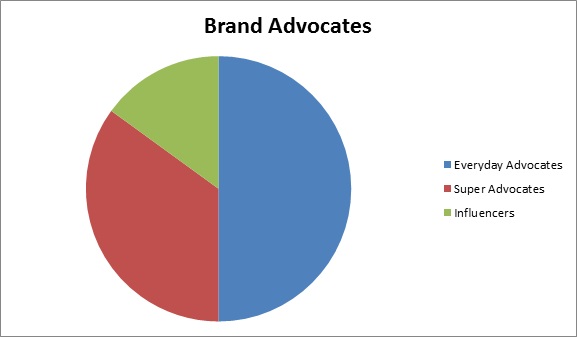
Everyday Advocates are those who share on a regular basis up to twice a day. They make up the largest single chunk of brand advocates. Super Advocates on the other hand are those who share three or more times in a day. Surprise and delight campaigns work wonderfully to nurture such types. The highest category of brand advocates is Influencers. They have a massive fan following that they have created primarily through organic methods. They use their outreach to create brand awareness and promote the product accordingly. Influencers must be leveraged as much as possible. Marketing touch points must be used to nurture such influencers. Provision of advocate codes to everyone is a reliable method of executing such campaigns. They then need to be tracked accordingly in to the database.
Conclusion
The concept of referrals is proving to be one of the masterstrokes of the retail industry. The year 2017 is primed to see further progress in this field. Extole is one of those market innovators that has created a seamless platform to engage with brand advocates.
Date:- January 17th, 2017-How to use Content to fuel your Account Based Marketing
Key Speakers: Mr. Jon Miller (C.E.O & Co-founder, Engagio) and Ms. Ann Handley (Chief Content Officer, Marketo)
Both the speakers are renowned authors of management and marketing books.
Evolution towards ABM
A few years back at Marketo, a demand generation engine used to exist, which was extremely effective. This engine was responsible for around eighty percent of all sales conversions. However, as the organization grew, its members now wanted to attract the bigger names and started casting their net wide. They then realized the limitations of traditional demand generation. They realized this method was literally about fishing using traditional nets. There was no control over the type of fish caught. On the other hand a more strategic input was needed to get those really big fish of choice. This gave birth to a new organization called Engagio and subsequently the market for Account Based Marketing (ABM) also grew.
Account Based Everything (ABE)
While utilizing the ABM principles, it was realized that the net total of all such marketing tools being used, resulted in a mere fifteen percent shift. Thus instead of marketing alone, a more holistic process involving several other approaches was needed to crack the code. A more personalized style of digital marketing involving social media and emails is needed. The holistic process involving ABM, Account Based Sales, Account Based Sales Development and Account Based Customer Success is together categorized as Account Based Everything (ABE). This method is so inherently customer-centric that the campaign becomes subordinate. Any ABE plan does not take off until thorough research is available on the customer base before the campaign may be designed.
Factors leading to Growth of ABE
· It allows penetration to more specific clients to drive better deals.
· Inbound marketing as a principle has been yielding reduced returns; this has meant that greater efforts at needed at outbound approaches.
· Technology has now made it possible for ABE to be scaled to deliver solutions to greater number of people.
ABM v/s other Strategies
Business research conducted by Engagio has clearly confirmed that ABM brings far wider benefits than other approaches in terms of Returns on Investment (RoI). There is a seventy five percent rise in Close Rate and twenty six percent in deal size. Even the metrics for measurement are different. It can be summed up using the following table:
|
Demand Generation |
ABM |
|
Focus on Leads |
Focus on Accounts |
|
Quantity of target preferred |
Quality in target expected |
|
Execution takes days or weeks |
Execution takes even months or years |
|
Creates pipeline of work |
The existing pipeline gets influenced |
|
New businesses are generated |
Existing businesses are optimized and then expanded upon |
|
Uses inbound marketing tactics |
Outbound marketing strategies applied |
Account Based Content
Content that is good for inbound marketing, is generally good for ABM as well. Simply, good content is hard to find and must be leveraged whenever identified. When it is not good, it gets passed off as Spam or cold calling. Before creating specific content, it is necessary to conduct through analysis of the customer. Deep insights will bring valuable business intelligence to the content creators so that relevant content can be distributed. Social media is a very good platform to listen to customers. It is personal and used regularly by people. Thorough knowledge of customer segments must be similarly backed up by insights on industry, business issues and innovations.
ABM is a thoroughly customer-centric methodology. Relationships ought to be built and the history of transactions studied. Door-openers also need to be established to get foothold into any organization. A checklist for this research must be compiled. The checklist must include items such as – market dynamics, key trends, growth drivers or inhibitors, financial health of company, SWOT, growth areas, initiatives worked on, organizational chart, key contact persons and company culture.
Sources for Business Insights
· Direct chats during sales rounds or events.
· Social media.
· Direct surveys.
· Blogs or newsletters.
· Reports from common connections.
· Press releases, investor calls and annual reports.
ABE Styles
The following pyramid will help explain the various strategies of the ABE approach.
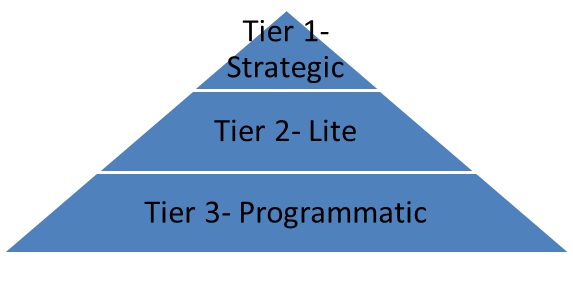
At the Strategic Tier 1 level, only the top connections must be placed at. Here all connections will be personalized but not more than a maximum of fifty key accounts must be placed here.
A maximum of a thousand accounts can be placed at the second level known as ABM Lite. Traditionally, only the top tier was known as AB, but now the others have come under the umbrella. This segment must be lighter on research as too much of it will not be relevant.
At the third tier, automated touches are preferred. There is no limit as to number of accounts, depending on the size and complexity of the marketing organization. This level is also called Programmatic ABE.
Content for ABE Tiers
The following table collates the kind of content ideal at each ABE level.
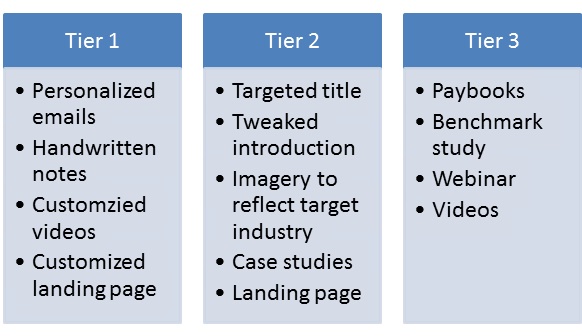
Content Creation Checklist
While developing the content, there remain a few pointers that the writers must take care of. They are as follows:
· Primary and next level research must be conducted.
· A deep audit or analysis must be made on resources or data already at the content creators’ disposal.
· Instead of being rigid, the creators must be bold enough to tweak the delivery as per market relevance and customer needs.
· An editorial calendar ought to be created, according to which the posting and delivery will take place.
Methods to Scale
In order to scale up, several steps have been identified that are as follows:
· Existing plans must be tweaked according to the corporate strategy being followed at that point in time. The strategies that could continue being successes must be retained.
· Content must be seen as modular assets that can be used repeatedly, though not exact replicas, but modified ones.
· Hubs must be designated around which campaigns can be run.
· Personalized content experiences need to be developed.
· ABM is not mass-marketing, thus quality is always preferred to quantity even at the relatively lower tiers.
· Editors are often under-valued but they bring great benefits to the business. They are inherently audience-centric and understand the pulse for the content consumption. The brand must opt for talent recruitment of any editor with real world publishing experience.
· The high level customization must only be applicable to Tier 1 clients.
ABE Market
The total ABE industry can be categorized under various subdivisions. The following map segregates the major players:
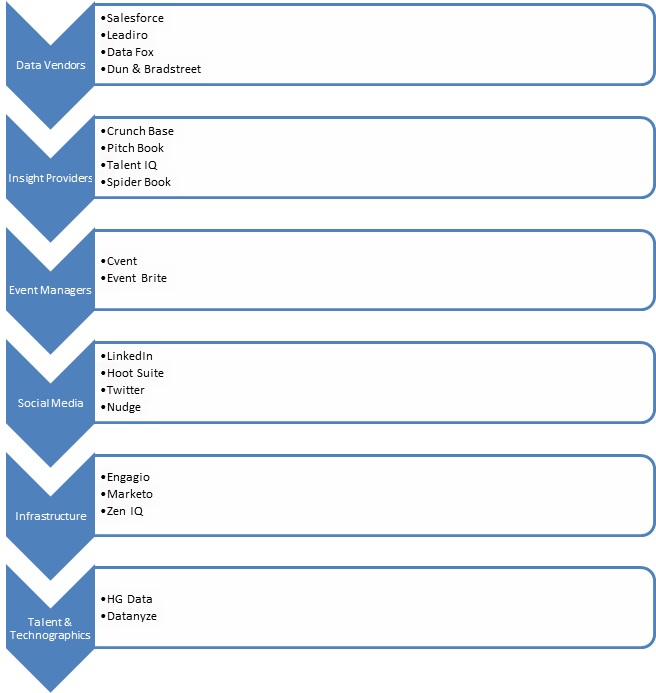
Conclusion
To end this write-up, it is very important that marketers realize that good content is always valuable whether it is ABE(M) or content marketing. However, in ABM, due diligence must be made to ensure the impact is measurable. Also there must be sufficient coverage to undertake such a campaign. This includes enough data or contacts to go ahead with the plans. Instead of maximum reach, the focus ought to be on the right contacts. The target accounts must be provided sufficient information about the marketing organization. And finally, there must be multi-pronged engagement with key stakeholders. This includes the right employees manning the key accounts.
Date:- December 22nd, 2016-Marketing Automation Strategy & Planning
Key Speakers: Ms. Maryel Roman (Marketing Manager- APAC, Marketo) & Ms. Bronwen Edwards (Head- Professional Services, Marketo)
Premise
Automation in marketing processes has already begun but this process is set to rise further. A lot of organizations and marketers are grappling with best ways to execute the same. This write-up explores the webinar which strategizes ways for marketers to make best use of this field without letting employees feel threatened about their place in the organization.
Present Trends
As per marketing research conducted by Marketo, it was realized that a staggering 91% of successful users polled, feel that automation is very important. They feel that automation leads to a 70% rise in overall customer engagement levels. Also it doubles up the conversion rate of leads to opportunities. It even triples the revenues driven through marketing functions. Per day, around two and a half hours of working time get saved by this. Such time saved can be used by marketers for fulfilling more creative pursuits.
The marketing funnel using automation can somewhat be explained using the following diagram:
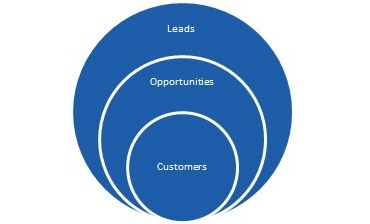
The final conversion depends on the effectiveness of the inside and field sales.
Marketing Maturity Curve
The curve has been significantly altered by the scheme of automation. It has moved beyond its earlier linear progression to a hybrid one. At the basic level, marketing automation seeks to integrate the entire CRM process. It allots scores to various sub-parts in the entire process. Each data point can then be rated on individual scores, so marketers get exact business intelligence on which aspects to target more, and which are already doing well. The nurturing of the customer segments then takes place automatically once the system is aware of individual touch points.
At the next level, automation makes full utilization of the entire funnel. Targeted marketing is conducted on specific segments. Dynamic leads get routed from various touch points. Triggers and alerts are disseminated often through the use of Push messages. At the final stage, a multi-touch attribution process is created. There is thorough reporting of operational aspects done using automation. The sales personnel get empowered as the CRM now uses sophisticated technical tools. The enormous amount of data warehousing that gets done by this stage, gets leveraged to predict customer moves. The CRM professional can thus stay ahead of the rest of the market.
Automation Focus Areas
There are four focus areas that must be tracked to ensure success. They are as follows:
· Marketing strategy
· Cross-functional alignment
· Sales and marketing funnel
· Measurement and reporting
Marketing Maturity Assessment
A baseline hypothesis has to be derived as to what the team has achieved till that stage and where all improvements can be made. A set of recommendations must now be presented. This has to be followed by a detailed plan being formed. And finally, the execution is conducted. Several third party market agencies exist which help out in devising marketing automation strategies for respective clients. Leads must be funneled from the scoring established on separate activities that have been conducted. A blueprint needs to be then established about the benchmark towards success. Clear metrics need to be selected which will help during the later reporting stage.
Cross-functional Alignment
This is amongst the trickiest stages in the process. Aligning all departments towards common organizational needs has always been a challenge even in modern organizations, less divided by silos. For sales, the only points that matter will be increase in the top line. Their concerns are very different from those of marketing, though unfortunately agencies often mix them into one. A clear level of empathy shown towards personnel from different departments can go a long way in establishing the pan-organization integration. For those at the top management, their ultimate objective is always business and revenue expansion. If automation cannot solve individual department issues, then each head will start questioning the value of the exercise and such doubts will percolate down.
Getting the right sort of data to measure the performances is another sound method of convincing department heads. For those who run the respective organizations, adequate data that will allow accurate business forecasting, is what will be seeking. The IT department needs to make sure that the data is secure at every stage and that there aren’t any leaks. As a support system to the organization, IT needs to remain reliable. Increasingly, IT is venturing to more than just support to marketing, but indeed as a partner. Automation will further increase its role.
Roles and Responsibilities
- Marketing automation requires that clear roles and hierarchies be allotted to different teams or people. These departments may be termed as the Centres of Excellence (CoE) which are as follows:
- CoE Executive Team- this one is in charge of aligning the direction and arranging the funds. They set the budgets and device the final target. An Executive Sponsor leads this team.
- CoE Strategy Team- this team sets the corporate strategy which needs to be executed using automation tools. They prioritize for the most important tasks to be then executed and also finalize the marketing processes to be applied. This team is led by the Marketing Operations Lead.
- CoE Architecture Team- this team does the actual execution of the plans under the guidance of various marketing practitioners. They bring out the reports to measure efficacy of campaigns. They use techniques of event management for which emails are an important part.
Adequate corporate training and development needs to be provided to various key stakeholders. This is especially pertinent for the marketing and sales personnel. Marketo is one such organization which provides these training sessions. Such training also enables leaky funnels to be rectified. Bad processes can be eliminated and so can campaigns which did not fit into the overall objectives.
Data Curation
Getting all data into one campaign is an arduous task but one which if executed properly can bring multiple benefits. The availability of such data will allow proper measurement of campaigns through the skill of business analytics. These can be compressed to Key Performance Indicators (KPIs) which indicate the performances of different streams of work. The said KPIs can broadly be classified into tactical and strategic ones. Tactical KPIs target the entire marketing funnel. A report on an email campaign may be one such example of a tactical KPI. The strategic KPI on the other hand solely targets the top management in any organization. It takes into account the leads taken from different sources, but compressed to form meaningful information for members of the C Suite or the board.
As a set of recommendations, one can suggest that the metrics and analytics arranged must be well organized. Also the organization must be proactive in order to curate data from various sources. Small wins must be leveraged on social media or other sources as this creates positive impression about the brand among the customer base.
Forum: https://www.marketo.com/
Date:- December 14th, 2016-Understanding Hidden Social Data and Technological Shifts
Key Speakers: Kerry O’Shea Gorgone (Director- Project Strategy & Training, MarketingProfs) & Mr. Michael Trapani (Product Marketing Manager, Watson Marketing)
Premise
It is a well known fact that the amount of marketing data available is immense now. In fact, an estimate puts it that each year 2.5 quintillion (18 zeros) bytes of data get produced and ninety percent of all time data has been generated in the last two years. This provides a great opportunity for marketers to engage with customers, yet proper usage of the same needs to be done in order to achieve such ambitions.
Existing Trends
We are existing in a golden age for marketing provided the brand leverages its public facing abilities. Thus different digital channels need to be used up. It is now impossible to be an outlier on price terms due to the fact that there is enormous sharing of information among customers. Entire teams are now created to facilitate such engagement. Data collection is not at all a problem as a lot is available anyway. The proper business analytics using this data is the main challenge. It is important for the brand to excel in the top two media by which its customers search on social media. Whether those two would include Twitter, Facebook, Snapchat, Instagram or anything else purely depends on the digital marketing strategy and need. But those two must be completely well owned at.
Dark Corners of Data
In spite of the enormous data available, several dark corners exist which are untapped. Not even social media can deliver such precise information. In order to reduce this gap, two tactics have been widely successfully used. One of them is URL Tracking and the other is Anonymous Visitor Tracking. URL Tracking allows traceable links to be created just like breadcrumbs can do in forests of the real world. URL shortening is one method that can be applied to execute this task. Anonymous Visitor Tracking involves progressive profiling of visitors. So all visitors need to be clubbed under buyer persona categories so that individually targeted marketing messages may be delivered to them.
Data Challenge
As discussed already, data collection may be a challenge but less so than its processing to create meaningful data warehousing. For this incremental moves may include steps such as CRM being linked to the marketing cloud or the systems being integrated with one another through smart devices. Through such data collected, implicit preferences need to be tagged so that personalized content may be delivered. Thus mass mailing may be replaced by push messaging once the customer gets identified to be of a certain type which prefers the latter media to the former. The mobile phone is now proving to be the greatest source of such critical data. It was earlier assumed that mobile phones were handy devices thus used while on the move. However, that myth has been shattered by the fact that people are now using mobile phones at all times. It is the most accessible device even at home, and not the computer as was previously assumed.
Artificial Intelligence
Artificial Intelligence (AI) throws up lost of implications based on user personas. For example it can provide insights on early adopters. Such people wish to engage with modern technology irrespective of its use simply because they are fascinated by innovations. Crucial business intelligence supplied by AI has confirmed that weather plays very important role in decision making. Thus weather data collection is of paramount importance. Disruption normalizes all forms of technology. Chatbots are a method of extracting crucial insights. They rely on AI or machine learning. They exist on all forms of chatting interfaces such as Google Allo, Whatsapp or Messenger. In order to survive, marketers need to decide whether they need to go for multi-channel single vendors or a multiple of them. Platform players are very useful but no one can claim to be able to resolve all problems. In fact, vendors must be willing to integrate into other systems as there is not yet any one single solution. Even the Internet of Things (IoT) used to be primarily on the B2B segment earlier but is now much more customer facing.
Prominent Vendors & Devices
Microsoft has already announced that they will shortly be out with washing machines and refrigerators that can respond to IoT devices. It is likely that such innovations with consumer durable products will come from Samsung or LG as they are major producers of such products. Companies that collect all this granular data about customers are not yet willing to share with marketers. This is actually a positive trend as marketers do not require such deep insights but only relevant ones. It has also been observed that chatting platforms differ based on region. The I-Messenger is very big in North America due to the large number of I Phone users. Also in North America, not much of international communication is needed as the domestic territory itself is vast. In Europe and in Latin America, Whatsapp rules the roost due to the cross-border connections the platform provides. At such places smartphones get delivered with Whatsapp already present by default. Line is extremely popular in Japan, Thailand and the rest of East Asia. We Chat is ubiquitous in China. We Chat has moved on from being simply into chatting services but now is more of an OS. The likes of Kik Messenger and Facebook’s native Messenger also have their respective local presence.
Date:- December 6th, 2016-Agile Marketing
Key Speakers: Ms. Andrea Fryrear (Founder & Chief Content Officer, Fox Content) & Ms. Raechel Duplain (Senior Marketing Program Manager, Workfront)
What is Agile Marketing?
Agile is one of those trendy words being thrown about recklessly these days. Yet it has a specified definition. It must not be used by anyone and everyone just because it is a fad. Agile marketing can best be understood using the following diagram:
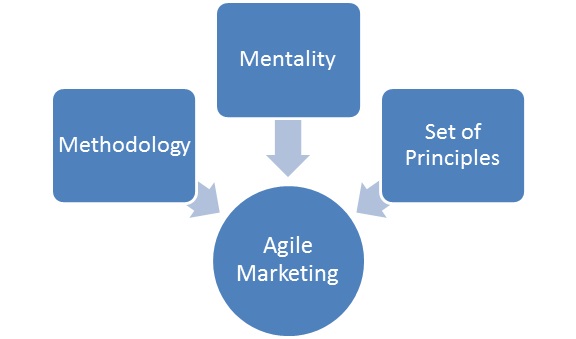
Myths around Agile
Lots of myths abound regarding agile marketing. It is commonly thought that it can be anything which is not structured but more flexible. It apparently changes all the time. Also, it is thought to be reactive as it abhors all planning. Fortunately it is none of that. In fact, a detailed corporate strategy for marketing is always needed, especially as operations become more complex. Also it is quite proactive and does not react to only market needs or competitor strategies.
Reasons to go for Agile
Marketers are increasingly taking a keen interest in this line. As per business research carried out by Work-front on marketers, it was understood that majority of them feel that their respective organizations are partially attuned to taking advantage of the agile methodology. The following chart will best explain the break-up:
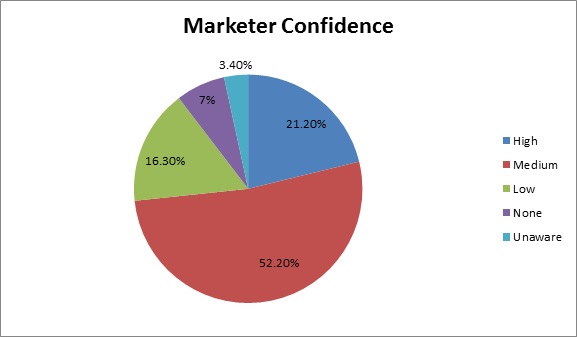
As this chart shows, just over a fifth of the marketers are genuinely confident that their firms can become agile. More than half are of the opinion that they are partially well placed. A significant number feels they aren’t in a good position while some even feel that they are totally out of the reckoning.
The same survey also found out that 84% of the users experienced improved team morale once agile marketing was implemented. Agile can actually prove to be even more successful in niche markets. It can enable gears to be changed quicker. Business innovations and disruptions can be adopted quicker while challenges responded to better. The overall team gets better prepared to handle such changes in work patterns.
Waterfall Method
The traditional method to execute project management is called the waterfall method. This is a cascading method where instructions move top-down. This is useful for large projects. It is highly linear and methodical where no stage can be implemented if the previous hasn’t been. It is also highly hierarchical in terms of control. This method may best be understood using the following illustration:
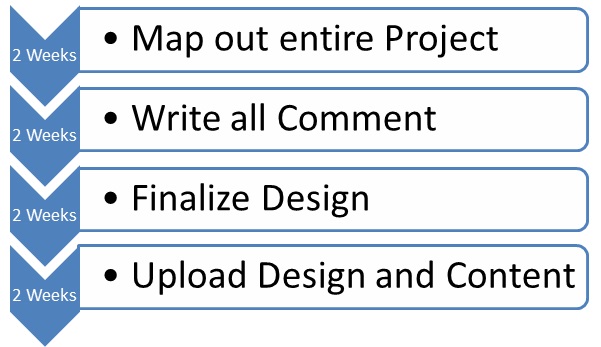
Thus we see that this process requires rigid planning and timelines. The knowledge of exact outcome is expected at the very beginning. Also several months or even years are engaged in the execution. In agile, the time to market is way quicker. During the process itself, tests are carried out so that changes can be made and incorporated into design. The management team needs to be make sure that not much of backlog stays back while moving on in the work. The Scrum methodology is used to cut back on iterations. This period is characterized by the sprint.
Agile Process
The agile process consists of a four staged window. Those four stages are as follows:
$1· Backlog
$1· Sprint
$1· Visual Storyboard
$1· Evaluation and Measurement.
During the sprint stage, there need to be plan meetings. Here the backlog is reviewed and stories that are top priorities need to be set up. The overall working hours needed is chalked out. Also it is decided as who is to perform which tasks. Assignments are created per person in the team. Typically such meetings are held on Fridays just before the close of work prior to the weekend. Some companies even do it first thing on Mondays or even Thursdays in case Fridays or Mondays are overloaded with work. Commitments are made by team members once staffing for each team is done. Typically sprint teams must not be that large, but be cohesive in nature.
The Visual Storyboard is a stage of demonstrating creativity. Some companies paste sticker son digital boards. Many others feature full length motivational films as a method of management training to inspire team members.
It is however very important to constantly evaluate using measurable metrics. Traditional marketing metrics such as leads, conversion rate and team satisfaction are assessed against benchmarks set. Data warehousing operations need to be conducted so that useful information can be stored and retrieved easily whenever possible. Here a term has been borrowed from the sport of Rugby called Scrum. This is one of the highlights of the agile process. As a rule, during scrums everyone needs to stand up. There is a scrum master who acts as the moderator of such meet-ups. The scrum master need not be someone who is a team leader but simply someone who voluntarily takes up said role. A daily status report is discussed here. Best practices are adopted and unproductive ones eliminated. A proper review takes place here. Major stakeholder concerns are addressed. Deliverables and their deadline dates are assessed. Ideally at least some changes always take place. This leads to finally the execution of the tasks.
Thus we see that agile marketing does not involve a checkbox. And it must not be viewed as a fad. Organizations must adopt it only if they feel it is going to benefit. By and large most organizations that have taken them up are those that have succeeded. Just as companies not internet savvy failed to take advantage of the boom in the 1990s and became redundant, similarly, agile is a tactic that the progressive thinking companies must adopt. Social media platforms especially Facebook and LinkedIn are very strong in this movement. Periodic meet-ups take place in Boston and San Francisco.


